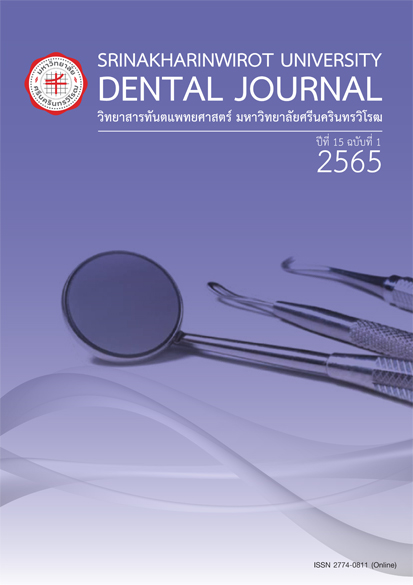ประสิทธิภาพของการใช้แปรงสีฟันปล่อยประจุไฟฟ้าต่อการลดคราบจุลินทรีย์และภาวะเหงือกอักเสบ
Abstract
วัตถุประสงค์: เพื่อศึกษาประสิทธิภาพของการใช้แปรงสีฟันปล่อยประจุไฟฟ้าชนิดใส่แบตเตอรี่ในการลดคราบจุลินทรีย์และลดภาวะเหงือกอักเสบในผู้ป่วยโรคเหงือกอักเสบวัสดุอุปกรณ์และวิธีการ: ทำการศึกษาทางคลินิกแบบไขว้แบบปกปิดสองทางในอาสาสมัคร จำนวน 30 คนแบ่งเป็น 2 กลุ่ม กลุ่มละ 15 คน คือ กลุ่มทดสอบที่ใช้แปรงสีฟันที่ใส่แบตเตอรี่ และกลุ่มที่ใช้แปรงสีฟันที่แบตเตอรี่ไม่ทำงาน แปรงฟันด้วยวิธีโมดิฟายด์บาส วัดค่าดัชนีคราบจุลินทรีย์ตามแบบ TMQHPI และ API และค่าดัชนีภาวะเหงือก GI ที่เวลาก่อนและหลังใช้แปรงสีฟัน จากนั้นเว้นระยะการทดสอบ 2 สัปดาห์ เพื่อสลับกลุ่มการใช้แปรงสีฟัน และแปรงฟันใหม่อีก 1 สัปดาห์ วัดค่าทางคลินิกก่อนและหลังการใช้แปรงสีฟันซ้ำอีกครั้งผลการทดลอง: เปรียบเทียบก่อนและหลัง แปรงสีฟันที่ปล่อยประจุไฟฟ้าชนิดมีแบตเตอรี่สามารถลดคราบจุลินทรีย์ TMQHPI (2.74 ± 0.53 และ 2.13 ± 0.62 ตามลำดับ) API (97.30 ± 8.63 และ 91.40 ± 12.60ตามลำดับ) และลดดัชนีภาวะเหงือก GI (0.96 ± 1.06 และ 0.46 ± 0.55 ตามลำดับ) ได้อย่างมีนัยสำคัญทางสถิติ(p < 0.05) และเมื่อเปรียบเทียบความแตกต่างระหว่างกลุ่มแปรงสีฟัน พบว่า แปรงสีฟันที่ปล่อยประจุไฟฟ้าชนิดมีแบตเตอรี่สามารถลดคราบจุลินทรีย์ TMQHPI และ GI ได้ดีกว่าแปรงสีฟันที่ปล่อยประจุไฟฟ้าชนิดแบตเตอรี่ไม่ทำงาน อย่างมีนัยสำคัญทางสถิติ (p < 0.05)สรุปผล: แปรงสีฟันปล่อยประจุไฟฟ้าที่มีแบตเตอรี่มีประสิทธิภาพลดคราบจุลินทรีย์ และลดภาวะเหงือกอักเสบได้ดีกว่าการใช้แปรงสีฟันปล่อยประจุไฟฟ้าที่แบตเตอรี่ไม่ทำงานคำสำคัญ: แปรงสีฟันปล่อยประจุไฟฟ้า คราบจุลินทรีย์ ดัชนีคราบจุลินทรีย์ ดัชนีภาวะเหงือกอักเสบ Efficacy of Ionic Toothbrush for Dental Plaque Removal andReducing GingivitisThanapoj Nilmoje Rungtiwa Srisuwantha Prima Buranasin Narongsak LaosrisinAbstractObjective: Clinical evaluation of ionic toothbrush on plaque and gingivitis reduction wasperformed.Materials and Methods: A double-blinded, crossover design study was conducted. Thirtyparticipants were divided into two groups; 15 participants first used an active ionic toothbrush (withbattery) as a test group, and 15 participants used an inactive toothbrush (without battery) as acontrol group toothbrushing. All participants did toothbrushing by the Modified Bass technique.Turesky Modification of the Quigley-Hein Plaque Index (TMQHPI), Approximal Plaque Index (API),and Löe-Silness Gingival Index (GI) was collected before and after using active and inactive ionictoothbrush. Washout period with 2-weeks was set. Another toothbrush was assigned to participantsfor 1 week. All clinical indices were recollected before and after toothbrushing.Results: When compare intra-group at baseline and after using active ionic toothbrush, therewas a statistical reduction in TMQHPI (2.74 ± 0.53, 2.13 ± 0.62 respectively), API (97.30 ± 8.63,91.40 ± 12.60 respectively) and GI (0.96 ± 1.06, 0.46 ± 0.55 respectively) (p < 0.05). There weresignificantly differences between active ionic toothbrushes battery and without the battery inTMQHPI and GI only. (p < 0.05)Conclusion: Ionic toothbrush with battery was significantly superior in reducing plaque andgingivitis than ionic toothbrush without the battery in TMQHPI and GI.Keywords: Ionic toothbrush, Plaque, Gingivitis, Plaque index, Gingival index ว.ทันต.มศว ปีที่ 15 ฉบับที่ 1 พ.ศ. 2565 หน้า 48-58. SWU Dent J. 2021;15(1):48-58.Downloads
Download data is not yet available.
Downloads
Published
2022-04-01
How to Cite
1.
นิลโมจน์ ธ, ศรีสุวรรณฑา ร, บูรณสิน พ, เหล่าศรีสิน ณ. ประสิทธิภาพของการใช้แปรงสีฟันปล่อยประจุไฟฟ้าต่อการลดคราบจุลินทรีย์และภาวะเหงือกอักเสบ. SWU Dent J. [Internet]. 2022 Apr. 1 [cited 2025 Dec. 17];15(1):48-5. Available from: https://ejournals.swu.ac.th/index.php/swudentj/article/view/14309
Issue
Section
บทวิทยาการ (Original articles)
License
เจ้าของบทความต้องมอบลิขสิทธิ์ในการตีพิมพ์แก่วิทยาสาร โดยเขียนเป็นลายลักษณ์อักษรแนบมาพร้อมบทความที่ส่งมาตีพิมพ์ ตามแบบฟอร์ม "The cover letter format" รวมทั้งต้องมีลายมือชื่อของผู้เขียนทุกท่านรับรองว่าบทความดังกล่าวส่งมาตีพิมพ์ที่วิทยาสารนี้แห่งเดียวเท่านั้น




